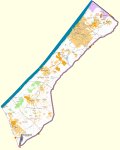Visiting Gaza
16. May 2010 - 26. May 2010A report by Peter Voss, part 7
Mouse click to enlarge photos, Alt + 'left arrow' to return
|
Day by day account
Monday, May 24, 2010 I had two extra days and in that way was back to my original total of five days. But I was not all that sure how to spend the time sensibly. I still saw the chance to meet somebody at UNRWA and unfortunately arranged a meeting at 1 p.m. for this day. In the morning I called Mr. Al Aa and we went south on the coastal road. When we approached one of the UN summer camps he stopped in front of it and he told me that this was the place where there had been an incident last night. I had read about it in the Internet (Reuters). About 30 masked and armed men had shown up during the night, handcuffed the guardsman, sliced up the plastic sheet walls, and burned the roofs and many of the plastic water tanks. According to Reuters "a previously unknown militant group, "The Free of the Homeland," issued a statement criticizing the camp's organiser, the United Nations Relief and Works Agency (UNRWA), for "teaching schoolgirls fitness, dancing and immorality."". I did it again; after taking the still photos the night before I had forgotten to reset the camera for the higher resolution video. But I think one still gets a good idea of what the place looked like. 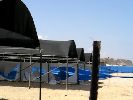 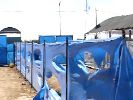 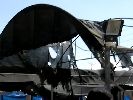 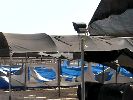 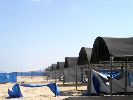 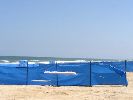 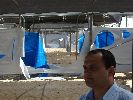  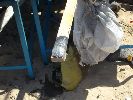 For the slicing job the attackers had prepared carpet knives on poles 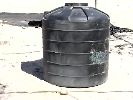 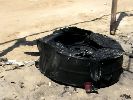 Before and after 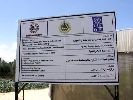 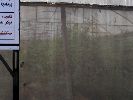 Another sign at one of the greenhouses in which apparently tomatoes were grown We stopped at one of the UNRWA schools near the Deir Al Balah camp near the coastal road. Originally I had had the intention to spend some time in the camp. The schools are operated in shifts. Still, I was surprised to see the primary school girls already going home shortly after 11:30 a.m.. I went into the school and talked to the head teacher, asking her what kind of problems the school had. Her answer was that they were pretty well supplied. They were "almost as good as the private schools.". She advised me to have a look at one of the non-UN schools down the road. 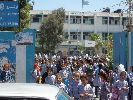 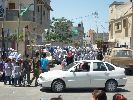 We drove over close to Salah El-Deen Street and stopped at Al'Manfaloti boys secondary school. When I walked into the courtyard all the boys stood there as for a roll call and were listening to a loudspeaker anouncement. I found the teachers' room. The teachers seemed pretty surprised and regretted that they were not allowed to talk to anybody who just happens to walk in without permission from the school authority. There was no chance to get that, because I was getting short of time already. 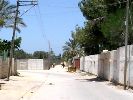 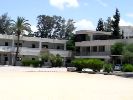 The English teacher felt that he could show me at least the sanitary facilities, which were in the back of the courtyard - two buildings with washbasins outside. The whole installation had only a single water tap for 800 pupils. The outside wall was going to fall over sooner or later. The boys were not allowed to get near it.  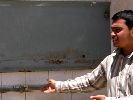 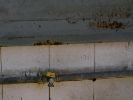 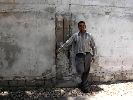 We had to go back to Gaza City to meet the UNRWA press person. This time I managed to film the greeting sign of Gaza City and the Ferris wheel nearby, that I never saw turning. 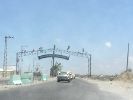 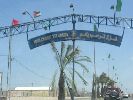  I was on time, but the press person did not show up for the next 40 minutes. I sat in his dusty office among piles of yellowed reports and watched Al Jazeera on the running TV. They showed an interview with Ann Wright, one of the Free Gaza flotilla organizers, whom I had met during the Gaza Freedom March in Cairo. When the press officer finally showed up, he unfortunately could not help me. 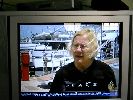 Since I was very close to the Islamic University I called there, asking whether somebody from the engineering department could update me on the situation of the building sector, but I was told to try again by noon the next day. I went back to the hotel. The hotel people introduced me to another German guest, Lukas Mall, a young man who had an Israeli permit to visit a particular project. As it turned out, he had finished that part and was on his way to visit a Psychosocial Center. I did not get the details, but since I had not met many locals, I asked whether I could go along. We walked up to the western corner of the Islamic University and then south (Al Dowal Alarabiyyah Jame'a Street) past Al Quds hospital. On the way we came past Al Azhar University. There was a group of young men in the courtyard holding on to a large Palestinian flag. I was very surprised when a passerby made some very derogative remarks, indicating that these people were not students. Across the streets from there were the ghostly ruins of the ministries complex. Further down the road was the Turkish cultural center, which during those days had a particular meaning. Next to the Al-Quds hospital was a parking lot. Here there used to be an annex of the hospital. It was attacked with phosphorus bombs. Across the street was a big empty space with only a few ruins where the buildings of the Civil Defense used to be. Next to this open space is the Psychosocial Center. In one of the rooms a music lesson was taking place. One has to keep in mind that according to the UN report quoted earlier fewer than 2 % of the children were not psychologically affected by operation 'Cast Lead'. Several girls were playing the piano for us, in one case together with their Russian music teacher (she is married to a Palestinian doctor). In an adjacent room a little boy was playing a zither quite well (mp3, 2.2 MB). He played very concentratedly and was obviously very proud at the end. 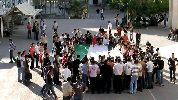  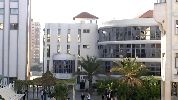 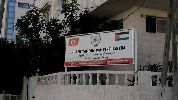 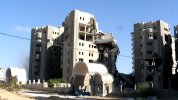 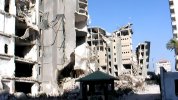  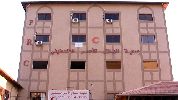 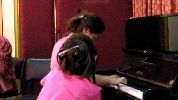 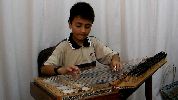 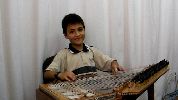 My stomach had pretty much recovered and I decided to go to a restaurant in town, away from the beach. I walked back to the hotel and approaching the intersection to the main road leading down to the beach, Omar Al-Mukhtar Street, and noticed an illuminated store that I had not noted before during daylight. It was a store for baklava-style cookies. I was very happy that I had actually found a souvenir from Gaza for my wife. 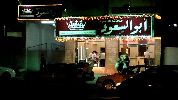  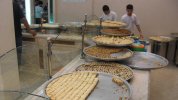
Tuesday, May 25, 2010 This was indeed my last full day. I decided to finally go for a longer bike ride. Just a few hours. Looking at the map I figured that I could go across the Gaza Strip south of Gaza City and be back in Gaza City by noon. I even took the time to get some GPS reference points from the Google Earth satellite map. Unfortunately I did not go to full magnification and therefore did not notice that there was a problem with my printed 'destruction' map right at the starting point at the coastal road. Instead of going along the route indicated green in the map I started out the red way. It was basically even the right way, but I should have turned right after a short stretch. I realized later that I was going in the wrong direction and took a side road (2) going 'south', but that ended in the fields. The other big surprise right at the beginning was that the roads, even in the urban areas were very sandy and that with the small wheels of my bike I had absolutely no chance riding on them. And since there were quite a few stretches were it went uphill I probably pushed my bike about one quarter of the time on these sandy roads. 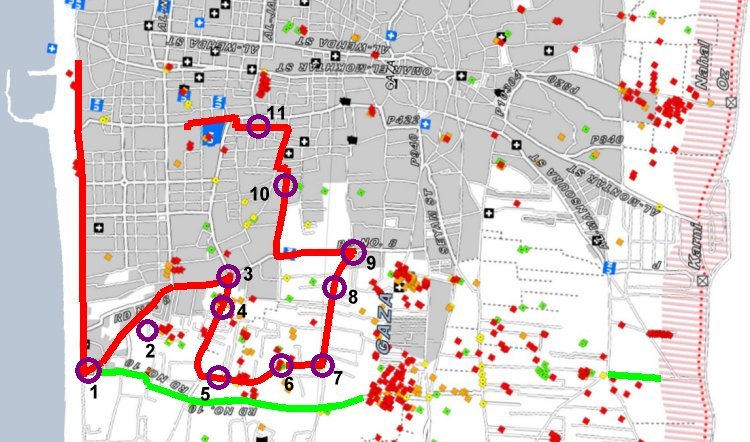 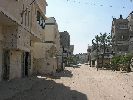 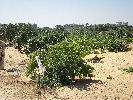  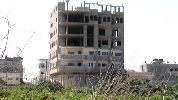 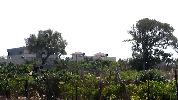 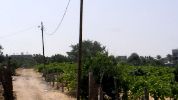 At the starting point 1; some bullet marks in the walls (2) Impressions of the fields, fig trees and grape vines  (3) Intersection of route 8 (Own Al-Shawwa Street) with Al-Aqsa Street (to the right). 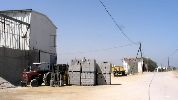 (3) I tried the road going 'south' again  Not very far from the main road I noticed these damaged buildings. The map marks two destroyed buildings and the satellite map of 2007 also shows five buildings in this location. Everybody can ponder for himself what might have been on the minds of the Israelis in the tanks driving along here to cause the damage to the houses and the wall in front of them.  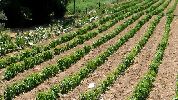 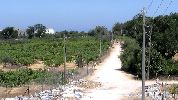 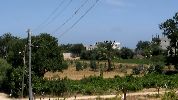 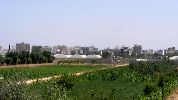 Impressions along the road, showing again how crucial irrigation seems to be. 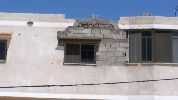 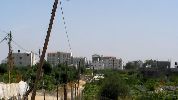 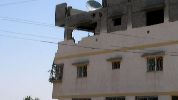 Location 6 was the spot that caused the strongest emotion in me during all my trip. A quiet place in the countryside with a few greenhouses and houses at a bend of the road. The sparrows were chirping and behind the windows in the first floor of one of these houses that had a crudely patched wall, the sound of children's voices could be heard (mp3, 0.5 MB, 30 s; mpg-video, 28 MB, 1 minute). A neighbor house had some still unrepaired damage. 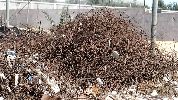 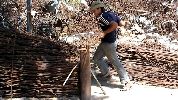 Further down the road (7) I noticed an activity that I had not seen before. In front of large piles of warped building iron rods, a farmer was unbending some of these rods and putting them on his horse drawn carriage. He did not want to be filmed. Therefore I asked a young man to stage it for me. The road did not continue and I had no choice but to go back to the main road. Here I saw another first: The sewage from one of the houses ran right into the street and from there into the field across from the house. 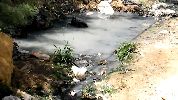 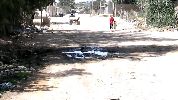 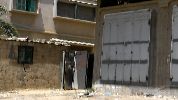  It was not all that hot, but the sun was strong and when I could actually ride on my bike through the sand I had to pedal with all the stength that I could activate. So I was happy to get closer to civilisation. There was a shadowy place in front of a house and I decided to have some rest. Across the street was a barber shop and I was invited in. But it was pretty warm in there and therefore I rather stayed outside. Somebody brought me a chair and I took a souvenir photo of everybody involved. 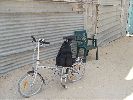 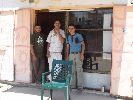 It was close to noon and I decided to take a ride into town and see whether I could find somebody to talk to at the Islamic University. 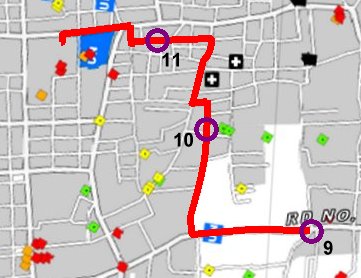  (9) I drove past another decapitated minaret. The second minaret also had some damage.   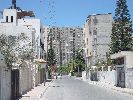 (10) Minarets (11) Side street, one of the high-rise buildings (Al-Sosi tower) in the background (with an unfinished back side fassade) I was lucky. Several of the professors of the faculty of engineering were present. The dean, Professor Jendia, gave me an interview (in German) on the situation of the building sector (youtube-video) 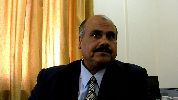 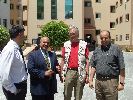 Professor Jendia; souvenir photo with professors Jendia and Arafa I went back to the hotel. The tire of the back wheel was going flat. Later I went to the harbor again and filmed the outer mole from the tip of the inner mole.  In late afternoon I went again to the area of the Beach Camp. Some boys asked me were I had my bike. 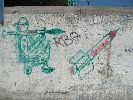  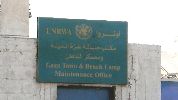 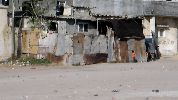 Palestinian grafitti; Stores selling items distributed by the UN right next to the distribution center. A 'building' across the street. I went into one of the stores and took some photos. I later tried to get some details on what is actually in a normal food package and how long it is supposed to last. Through my contacts to the UN in Gaza I could only get very general information. However, after some searching I succeeded in finding detailed data (see special page).   Further along I met an older man who spoke English quite well. He told me that in his house (second photo below) there are 34 people living in a space of 100 square meters.  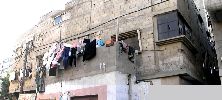  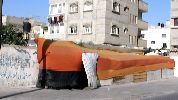 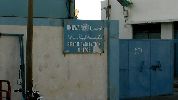 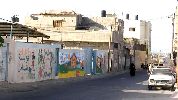 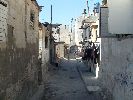 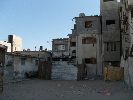 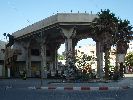 Some more impressions of the camp. The gas station in the last photo is just a few hundred meters away from the camp. In the evening Dr. Yussef El Modalal came to the hotel and gave me an interview on the situation of the health sector (in German, youtube-video). 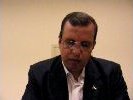 Wednesday, May 26, 2010 My driver for several days, Mr. Al Aa, drove me to the Rafah crossing. We drove through Deir Al-Balah and he pointed out the repaired road. Here the Israelis had ploughed a trench into the main road during operation 'Cast Lead'. 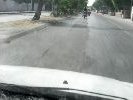 I expected my crossing into Egypt to be smooth this time, but that was not quite the case. It took seven hours before I stepped out of the gate of the Egyptian terminal. Since the weekend was coming up, I wanted to get back to Cairo that evening. The bus from El-Arish had left already. The taxi driver found the limousines. It was already 6 p.m., but to my relief it was no problem to get somebody who was willing to take me on the four to five hour drive to Cairo. The taxi driver seemed relaxed and obviously enjoyed driving, with full confidence in the performance of the old Mercedes. As it was getting dark we met a convoy of about 30 trucks with Palestinian flags attached to them going the other direction. I was told later that they were carrying supplies donated by the Emirates. Close to the Suez Canal I had a last scare. The driver turned the car around and a short time later another taxi arrived. People got out and started unloading my baggage from my taxi and putting theirs in. It took a while before with the help of the hotel in Cairo my driver could explain to me that we were continuing our trip in the other taxi. By 11 p.m. I was back to the familiar surroundings of Tahrir Square in Cairo. 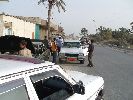 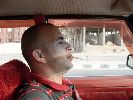 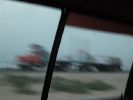 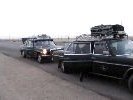
Getting a limousine in El-Arish; the driver, flagged convoy to Gaza; changing taxis As I was writing this report, the flotilla event was taking place. Nine people died because they wanted to bring some help to the population of Gaza. The event has caused Egypt to open the Rafah crossing permanently, though this does not mean that the transfer has become very easy. Israel supposedly has relaxed the blockade, letting in some minor things that came in through the tunnels anyway. An indication of how little things have changed is given by the news that Israel wanted to deliver the electric wheelchairs from the flotilla to Gaza without batteries and chargers (New York Times, June 30, 2010). A real change will only occur when the local economy is enabled to recover (AP, July 21, 2010). One can hope that some of the reconstruction projects will get on the way now and that there will be improvements to the infrastructure. I would like to express my thanks to those who made this trip possible for me. Back to contents page
|
